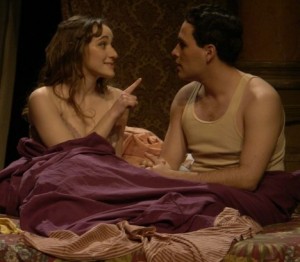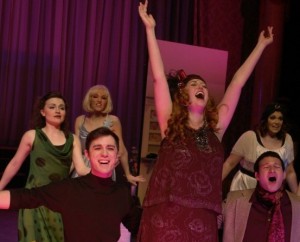The Golden Age of Hollywood conjures ideas of glamour, romance and Technicolor hues—but behind the scenes, the reality of the industry wasn’t always the rosy picture portrayed on screen. These two sides of Hollywood’s past are now being explored in The Girl Who Jumped Off the Hollywood Sign, a one-woman show that transports the audience back to the Hollywood of yore.
Panel on Hungarian dramatist planned
A special panel discussion about Hungarian playwright George Tabori will be held at 6 p.m. Wednesday, April 26, at the Museum of Jewish Heritage, 36 Battery Place. The panel on the satirical playwright is a prelude to the presentation of his two works, Mein Kampf and Jubilee, that are scheduled in repertory May 4–21 at Theater for the New City (155 First Ave., between 9th & 10th streets. The panel will include frequent Tabori producer Wynn Handman; critic and author Jonathan Kalb ; Lincoln Center Library for the Performing Arts Assistant Theatre Curator Annemarie van Roessel; American composer Stanley Walden (who collaborated on more than 50 Tabori projects), and Lena Tabori, the publisher of Welcome Books. To RSVP to this free event, write to contact@taboriproject.org.
A Queer Wonderland
Lewis Carroll’s Alice in Wonderland and Prohibition-era speakeasies in New York City may not seem like kindred worlds, but Danny Ashkenasi blends them together in his new musical Speakeasy: John & Jane’s Adventures in the Wonderland. Indeed, both Carroll’s wonderland and Ashkenasi’s queer underworld in Speakeasy are ruled by chaos, intoxication, and frenzy. For better and for worse, director Lisa Moira’s production of this new musical is similarly chaotic; but in spite of technical glitches and some awkward performance moments, the cast of Speakeasy offer some sparkling moments of musical theater.
The standout performances in Speakeasy often offset the production's technical creaks. Kayleigh Shuler as Jane and Matias Polar as John are the heartbeat of the show; they are the flawless young lovers, never missing a note or a cue. As Jane’s best friend, hooch-maker, and possible extramarital love interest, the fiery Bevin Bell-Hall charms the room as Roberta White. The characters of Duchess Bentley (Camille Atkinson) and Julian Carnation (Tim Connell) represent the struggles of Julian Eltinge and Gladys Bentley, queer denizens of Prohibition-era New York City. Atkinson and Connell portray their gender-bending historical characters with sensitivity and humor.
Finally, absolutely knocking the Ziegfeld-girl aesthetic out of the park are Alice Radice and Anne Bragg as Dora and DeeDee Tweedle. Just try to keep from smiling as Radice and Bragg shuffle around the stage in their blonde bobs and lobster-claw hands. With their stellar comic, dance and musical skills, this vaudeville duo steals the show.
One moment of great synergy in Speakeasy is the song “All Hail the Maidens,” which most of the ensemble performs in drag. While the blocking in many of Speakeasy’s scenes fail to fill the large theater space, J. Alan Hanna’s choreography for “All Hail the Maidens” is exuberant and fun. Torian Brackett, Cody Keown, Sylvester McCracken III, Nick DeFrancesco and Brandon Mellette are gorgeous and fabulous in drag. This moment of the show gives a rare glimpse of the hidden safe spaces made available to queer and non-gender-normative people in Prohibition-era New York.
Speakeasy tries to do a lot in three hours. It is at once a fantasy adventure, a sexual coming of age, a straight love story, a piece of historical fiction, a gay play and a musical. Songs like “Once I had a Friend,” “Shadow and Light,” and several other numbers probe human sexuality and the tension that exists between status quo and queer desire.
Speakeasy gives short shrift, however, to the racial tensions that loomed large during this historical era (and in many ways, still loom today). In the song “Harlem,” the all-white ensemble sings of slumming uptown. Slumming was the practice of middle- and upper-class white people venturing into poor neighborhoods of New York to dance, drink, and have sexual encounters with people of color. As the ensemble for “Harlem” cavorts, Brandon Mellette sweeps up their mess upstage (and is the only person of color visible). The song gestures towards a larger issue of racial inequality, and the appropriative politics of slumming; but after “Harlem,” the issue is not further explored. With a bevy of songs exploring queer sexuality, it seems that historical racial tension deserves more attention from a show entitled Speakeasy.
Finally, as a brand-new musical, Speakeasy needs a polishing of its more technical points. For whatever reason, there are many moments when Bri Malloy as Chet Cheshire is not off book, and his voice gets lost upstage. Furthermore, though Darcy Dunn’s powerful voice as Caroline Chrysalides can compete with the pianist, many other solo voices are lost in the din. Line flubs and costume malfunctions also threaten to take an audience member out of the experience. This is no surprise, because the show is huge in scope—with more than 30 musical numbers and a lot of scenic transitions. Perhaps a scaled-back version of Speakeasy, with fewer plot offshoots and shorter musical numbers, would result in a more polished final product.
This is not to say that Speakeasy lacks charm; it simply lacks polish. Speakeasy satisfies many interests, and might be enjoyed by fans of drag, lovers of Alice in Wonderland, and history buffs interested in Prohibition-era New York. It is a marathon of a show, but contains performance gems that are worth the wait.
Speakeasy: John and Jane’s Adventures in the Wonderland runs through March 13th at Theatre for the New City. Evening performances are Wednesdays through Saturdays at 8 p.m.; matinees are Saturdays at 2 p.m. and Sundays at 3 p.m. Tickets are $18. Visit TheaterForTheNewCity.net or call SmartTix at 212-868-4444.









